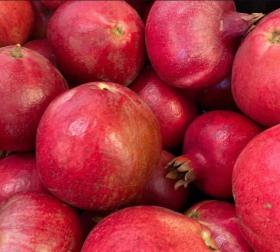What do the Andalusian Spanish city of Granada, the Grenadine syrup well known to little ones, and those military projectiles that are never good to encounter on your road have in common? All three derive directly or indirectly from a round, dark pink fruit when ripe, "ready to burst," and filled with a multitude of crunchy, fleshy grains with a sweet and tangy flavor: the Pomegranate (Punica granatum), "grains in abundance," still called "Millegraine" or "grain apple" in the Middle Ages.
Originally from Asia Minor, and possibly Persia or Armenia, the pomegranate is a prestigious biblical fruit that gradually spread throughout the Mediterranean region. Its first appearance dates back to the Old Testament. It is found in hieroglyphic texts and the Odyssey alongside the pear and apple trees. The pomegranate tree is one of the oldest shrubs in the world.
Long considered the crown jewel of creation due to its persistent calyx, the pomegranate is also a symbol of fertility and childbirth. It was customary in Rome to adorn Roman brides with a pomegranate branch. The goddess Aphrodite made it the fruit of love before that.
The pomegranate tree and its fruit are from the Punicaceae family and are characterized by their very high content of gallic acid-type tannins, which give them unrivaled astringent properties. Pliny the Elder, also called the bark of the pomegranate Malicorium or "apple leather," refers to its tanning properties.Called "balusters," the flowers are used in decoctions to fight intestinal ailments. The leaves used in herbal teas are appetite stimulants indicated in cases of general fatigue. The juice of the seeds is refreshing, diuretic, and softening; it is included in many anti-inflammatory eye compositions.
